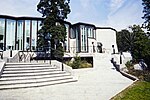Seurasaari

Seurasaari (Swedish: Fölisön) is an island and a district in Helsinki, Finland, known mostly as the location of the Seurasaari Open-Air Museum, which consists of old, mainly wooden buildings transplanted from elsewhere in Finland and placed in the dense forest landscape of the island. Every summer, many Helsinkians come to Seurasaari to enjoy the rural, peaceful outdoor atmosphere. Despite the visitors, the island has a variety of wildlife, especially birds, but also red squirrels and hares. The height of the island's popularity is at Midsummer, when a huge bonfire (Finnish: juhannuskokko, Swedish: midsommareld) is built on a small isle just off the island's coast, and ignited by a newlywed couple. Thousands of people, both tourists and Helsinkians, watch the burning of the bonfire from both Seurasaari itself and from boats anchored near it. Seurasaari also includes one of only two nudist beaches in Helsinki and one of only three in the entire country. Unlike the other nudist beaches, the beach is segregated for men and women separately with no unisex nudist area and is subject to a fee.
Excerpt from the Wikipedia article Seurasaari (License: CC BY-SA 3.0, Authors, Images).Seurasaari
Seurasaarentie, Helsinki Meilahti (Western major district)
Geographical coordinates (GPS) Address Nearby Places Show on map
Geographical coordinates (GPS)
| Latitude | Longitude |
|---|---|
| N 60.183333333333 ° | E 24.883333333333 ° |
Address
Seurasaaren ulkomuseo
Seurasaarentie
00270 Helsinki, Meilahti (Western major district)
Finland
Open on Google Maps









